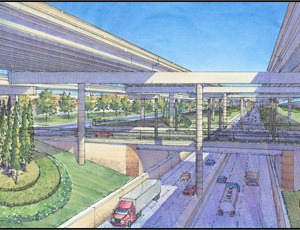With 270,000 vehicles traveling daily on Dallas’ LBJ Freeway (IH-635) and 500,000 projected by 2020, the start of the $2.7-billion LBJ Managed Express project by mid-year couldn’t come sooner.

The project will keep the same number of existing lanes, adding a continuous frontage road and four toll lanes while eliminating the current HOV lane, Andy Rittler, corporate affairs director for the project developer, LBJ Infrastructure Group, tells Texas Construction.
“The goal is to keep as many lanes open as possible during the construction and eventually double the road capacity,” he says.
LBJ Infrastructure Group is a public-private partnership led by Cintra of Spain, which has U.S. headquarters in Austin. Other partners include Meridiam Infrastructure of New York, the Dallas Police and Fire Pension System, Houston-based W.W. Webber and Ferrovial Agroman of Spain.
Taxpayers will foot about $450 million of the project, which is mostly absorbed by the LBJ Infrastructure Group. It will lease the roadways from the state over the next 52 years. The project is scheduled to be complete in 2016, and will be maintained and operated by the group until 2061.
Three big road construction projects in the area will occur simultaneously, Rittler says. They are the LBJ project, the DFW Connector and the North Tarrant Express.
LBJ is about six months ahead of schedule.
The work will move from the outside in, with sound walls built before overpasses. With incentives to work in non-peak hours, the firm pays the state about $6,000 per hour to “rent” the roads during the off-peak times, Rittler says, and up to $32,000 per hour to build during rush-hour.
“As the developer and contractor, it is in our best interest to do in the off-peak hours like evenings and weekends and notify the public when it will occur, so they can avoid it,” Rittler says.
The new LBJ will offer motorists a choice, Rittler says. Right now, there is no choice. “You get on LBJ and sit in traffic,” he says. “It will be a little bit of a pain over five years, but the result will be an asset to Dallas.”

Post a comment to this article
Report Abusive Comment